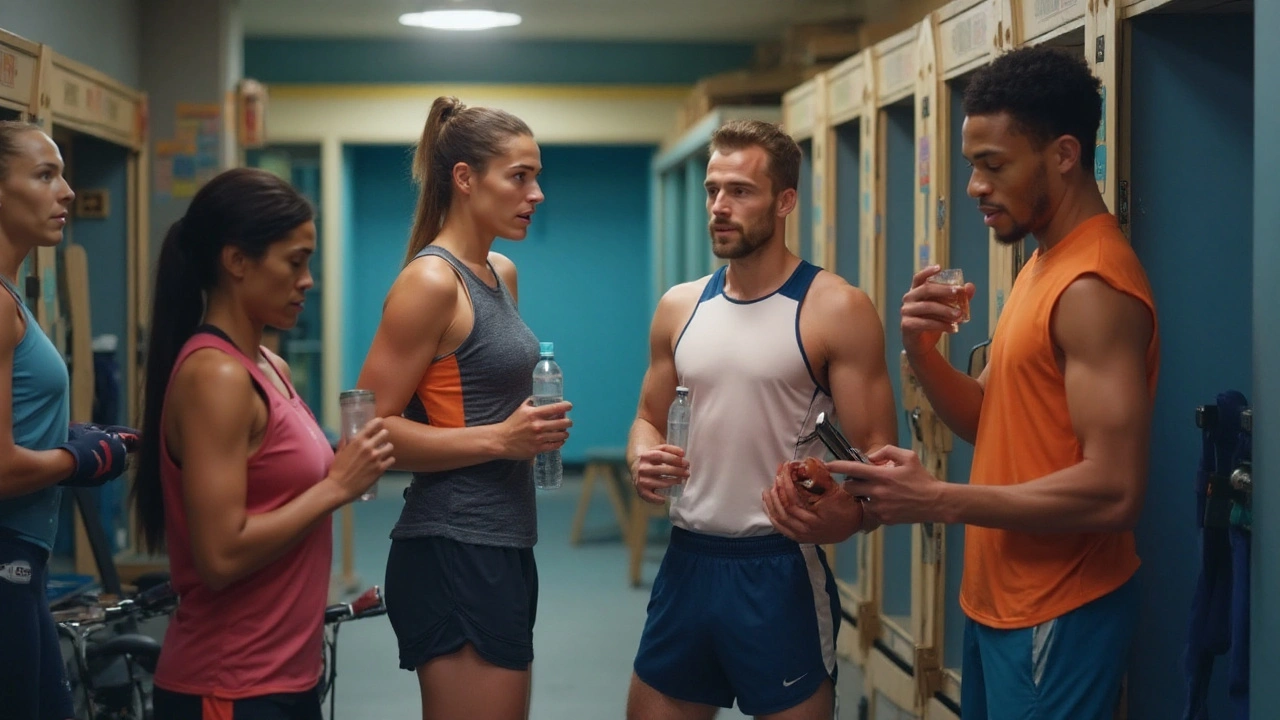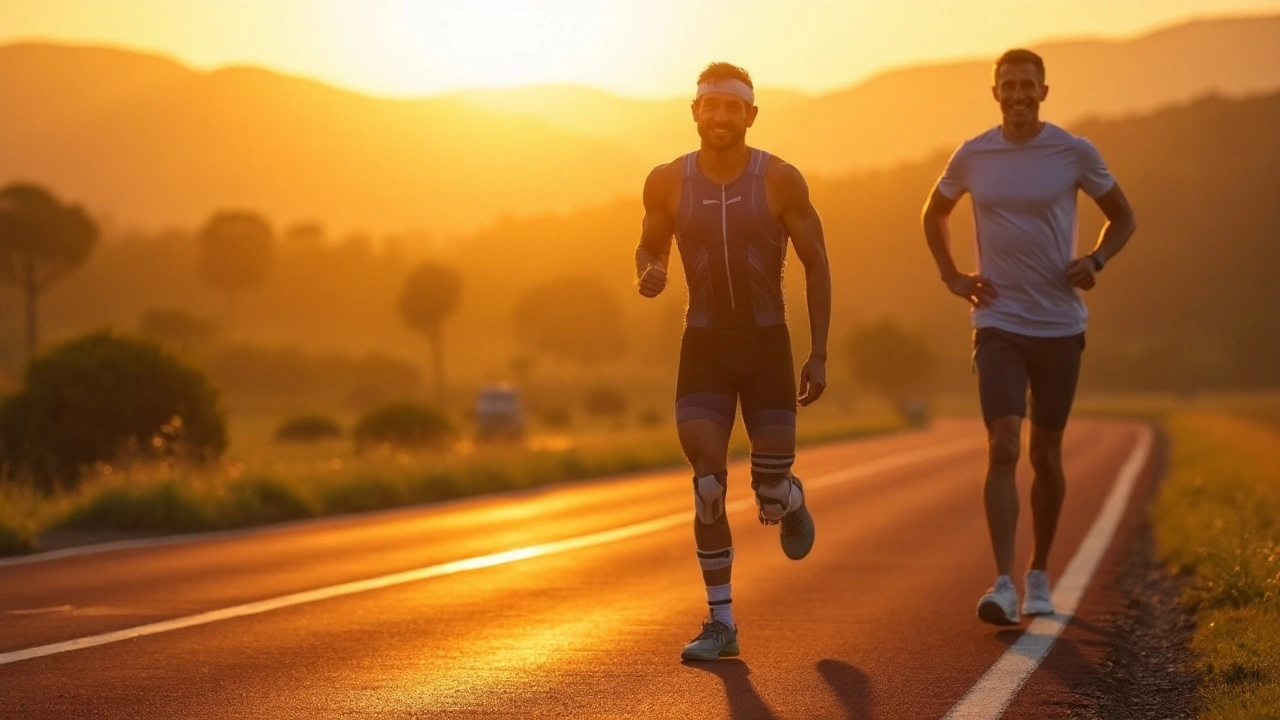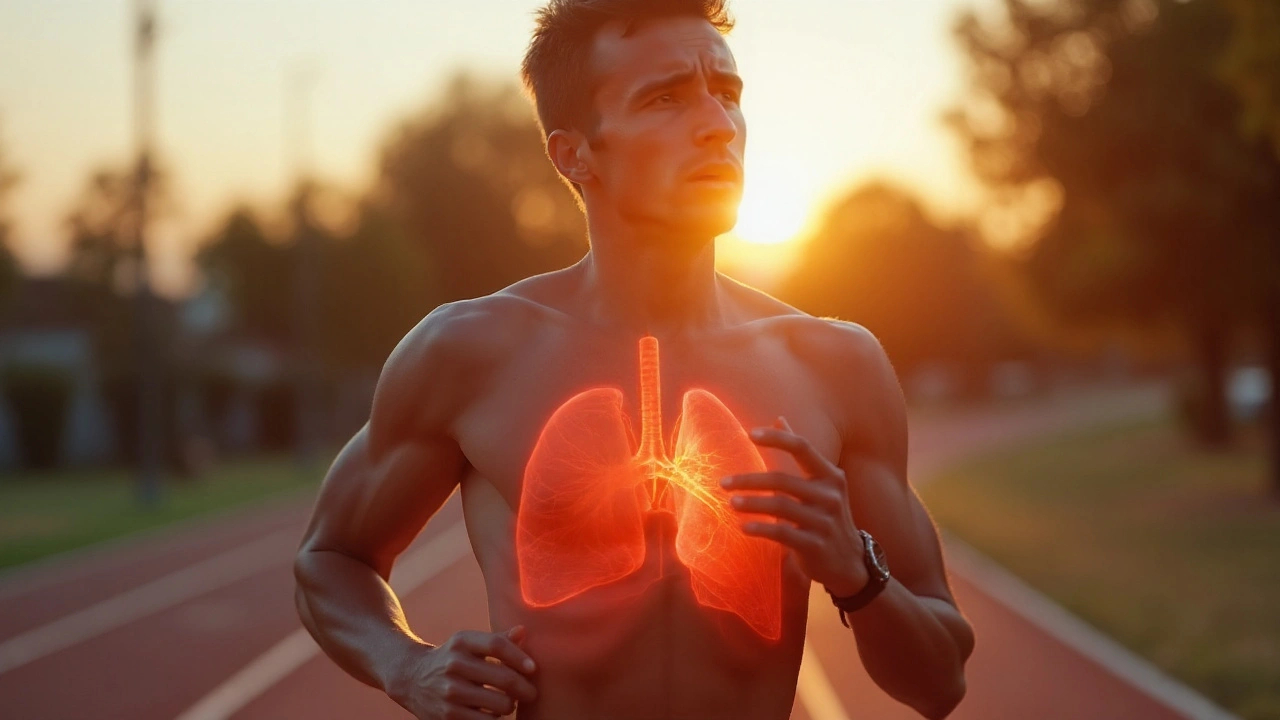Pulmonary embolism is a life‑threatening blockage of a pulmonary artery by a blood clot that can strike even the fittest individuals. When this condition appears in high‑performance athletes, the stakes rise: sudden collapse, loss of oxygen during intense effort, and complex decisions about returning to sport. This article unpacks the specific pulmonary embolism in athletes scenario, laying out the science, warning signs, and a step‑by‑step roadmap for safe recovery.
Why Athletes Aren’t Immune: Key Risk Factors
Most people associate blood clots with long flights or sedentary jobs, but athletes confront a unique mix of triggers. Understanding these helps coaches and medics spot danger before it escalates.
- Deep vein thrombosis (DVT) is a blood clot that forms in deep veins, usually of the thigh or calf. When a DVT dislodges, it can travel to the lungs and become a pulmonary embolism.
- Dehydration during prolonged training or heat exposure concentrates blood, raising clot‑formation risk.
- High‑intensity interval training (HIIT) creates brief periods of vascular stasis, especially when combined with tight compression garments that are too restrictive.
- Underlying genetic mutations such as Factor V Leiden a hereditary clotting disorder increasing thrombosis risk can be uncovered only after an event.
- Recent surgeries or invasive procedures (e.g., arthroscopy) add a transient clotting window of 2‑4 weeks.
Research from the British Journal of Sports Medicine (2023) shows that elite endurance athletes have a 1.8‑fold higher incidence of VTE compared with the general population, largely driven by dehydration and prolonged immobilisation after injury.
How to Spot the Early Signs
Prompt recognition can be the difference between a quick return and a life‑threatening emergency.
- Sudden shortness of breath that worsens with exertion. \n
- Sharp chest pain that may mimic musculoskeletal strain.
- Rapid heart rate (tachycardia) out of proportion to activity level.
- Unexplained light‑headedness or fainting during training.
- Swelling or tenderness in a calf, especially after a hard session.
When any of these symptoms appear, a cardiopulmonary exercise test (CPET) objective measurement of heart and lung function during graded exercise can help differentiate cardiac causes from a clot.
Diagnostic Toolbox for Athletes
Because athletes often push through discomfort, clinicians rely on a layered approach.
- Blood test for D‑dimer a fibrin degradation product that rises in clotting events. A normal level virtually rules out PE in low‑risk cases.
- Risk scoring using the Wells score clinical tool that quantifies PE probability or the revised Geneva score.
- Imaging: CT pulmonary angiography (CTPA) gold‑standard CT scan that visualises clots in pulmonary arteries.
- Echocardiography to assess right‑ventricular strain, a marker of severe emboli.
Prevention Strategies Tailored for Athletes
Prevention blends medical prophylaxis with training tweaks. Below is a side‑by‑side look at common measures.
| Measure | Target Risk | Implementation Tips | Potential Drawbacks |
|---|---|---|---|
| Hydration Protocol | Dehydration‑related hypercoagulability | Weight‑based fluid intake before, during, after sessions | Excessive fluid may cause hyponatremia if not balanced |
| Graduated Compression Stockings | Venous stasis after long travel or immobility | 22‑30mmHg, worn 6‑12h daily post‑injury | Improper fit can worsen circulation |
| Low‑dose Anticoagulant (e.g., rivaroxaban direct Factor Xa inhibitor) | High genetic or acquired thrombosis risk | 2mg daily for 3‑6months under physician supervision | Bleeding risk; requires monitoring of renal function |
| Periodic Mobility Breaks | Prolonged static postures (e.g., post‑surgery) | 5‑minute leg‑pump exercises every hour | May interrupt training flow |
| Genetic Screening | Inherited clotting disorders | Targeted testing for Factor V Leiden, Prothrombin G20210A | Cost; psychological impact of positive result |
Choosing the right mix depends on the athlete’s sport, travel schedule, and personal clotting profile.

Acute Treatment Pathway
When a clot is confirmed, time‑critical therapy begins.
- Stabilisation: Oxygen supplementation, haemodynamic monitoring, and pain control.
- Anticoagulation: Intravenous heparin loading followed by transition to an oral agent such as rivaroxaban or apixaban.
- Thrombolysis: Reserved for massive PE with circulatory collapse; administered as alteplase infusion.
- Catheter‑directed thrombectomy: Emerging minimally invasive option for athletes who need rapid restoration of pulmonary flow.
Evidence from the 2022 ESC guidelines emphasises early mobilisation once haemodynamically stable - a key advantage for maintaining conditioning.
Recovery & Return‑to‑Play (RTP) Protocol
Getting back on the field is a graded, multidisciplinary process.
- Weeks 0‑2: Bed rest is no longer routine; light walking and breathing exercises are encouraged.
- Weeks 2‑4: Introduce low‑impact cardio (e.g., stationary bike) while maintaining therapeutic anticoagulation.
- Weeks 4‑6: Begin sport‑specific drills under supervision of a sports physician and physiotherapist.
- Weeks 6‑8: Full training resumption if repeat D‑dimer levels remain within normal range and imaging shows clot resolution.
- Post‑8 weeks: Ongoing anticoagulation for at least 3 months, then risk‑based reassessment. Periodic CPET can verify cardiopulmonary capacity.
Psychological support is often overlooked; fear of re‑injury can hamper performance, so mental‑health counselling is recommended.
Related Concepts and Future Directions
The discussion of Venous thromboembolism (VTE) umbrella term covering DVT and PE opens doors to broader topics:
- Impact of high‑altitude training on clotting factors.
- Role of wearable technology in detecting early tachycardia spikes.
- Emerging direct oral anticoagulants with reduced bleeding profiles.
- Guidelines from the British Sports Medicine Association (BSMA) for post‑surgical thromboprophylaxis.
Readers interested in deeper dive can explore next‑step topics such as “Genetic Testing for Thrombophilia in Athletes” or “Optimising Warm‑up Routines to Reduce Vascular Stasis.”
Quick Takeaways
- Athletes face unique PE triggers: dehydration, intense training, and post‑injury immobility.
- Early symptoms mimic common sports complaints; watch for sudden breathlessness and calf swelling.
- Diagnosis hinges on D‑dimer, risk scores, and CT pulmonary angiography.
- Prevention blends hydration, compression, selective anticoagulation, and genetic screening.
- Return‑to‑play is a structured 8‑week ladder, with ongoing monitoring and mental‑health support.

Frequently Asked Questions
Can a healthy athlete develop a pulmonary embolism without any known risk factors?
Yes. Even elite athletes can suffer a PE as a first manifestation of an undiagnosed clotting disorder like Factor V Leiden. Sudden onset of breathlessness or chest pain should never be dismissed, regardless of fitness level.
Is anticoagulant therapy safe for high‑performance training?
Modern direct oral anticoagulants (DOACs) such as rivaroxaban have predictable dosing and low monitoring requirements, making them compatible with training schedules. However, the athlete must avoid contact sports during the peak anticoagulation window to reduce bleeding risk.
How does dehydration specifically increase clot risk?
Dehydration raises blood viscosity and activates the coagulation cascade, especially the fibrinogen pathway. Studies show a 30‑40% increase in D‑dimer levels after a 2‑hour high‑temperature workout without fluid replacement.
When can an athlete resume competitive events after a PE?
Most guidelines recommend a minimum of 6weeks of supervised rehabilitation, provided imaging shows clot resolution and the athlete has completed the staged RTP protocol without recurrent symptoms. Final clearance is given by a sports cardiologist.
Are compression stockings necessary for all athletes?
They are most beneficial for athletes who travel long distances by air or sit for extended periods post‑surgery. For runners who are constantly moving, the benefit is marginal and may even cause discomfort if too tight.


Comments (20)
Krysta Howard September 25 2025
Look, athletes think they're invincible, but the clot risk is real – stay hydrated, watch that calf swelling, and don't ignore a sudden bout of breathlessness. If you suspect anything, get a D‑dimer ASAP and push for imaging; delay can be fatal. 🙄
Elizabeth Post September 27 2025
Totally agree, staying on top of fluid intake and using properly fitted compression gear can make a huge difference in preventing those hidden clots. Keep the team educated and the rehab staff on board.
Brandon Phipps September 29 2025
From a clinical perspective, the cascade starts with endothelial injury, then hypercoagulability, and finally stasis – the classic Virchow's triad that athletes can inadvertently hit during ultra‑long sessions. It's fascinating how dehydration spikes blood viscosity, making the clotting cascade easier to trigger. The literature even shows that elite cyclists have a measurable rise in fibrinogen after a 3‑hour ride without fluids. Moreover, post‑injury immobilization for a few weeks can tip the balance toward thrombosis, especially if compression stockings are ill‑fitted. So, a systematic prevention protocol is not just nice-to-have; it's a necessity for any high‑performance program.
yogesh Bhati September 30 2025
Yo man, its not just about the bigy sprints – even those chill cool‑down stretches can cause blood to pool if you sit too long after a session. Best to keep moving a bit, maybe do some leg pumps while you wait for the shower! ;)
Akinde Tope Henry October 2 2025
We can't let foreign guidelines dictate our training – our own protocols work best. Stick to proven local methods and don't over‑complicate.
Brian Latham October 4 2025
Fine, but it’s just another article.
Barbara Todd October 6 2025
Wow, that’s intense.
nica torres October 8 2025
Keep pushing, team! Remember, staying hydrated and listening to your body are the secret weapons to stay on top of the game. 🙌
Dean Marrinan October 10 2025
Oh great, another “must‑read” on blood clots. Because we definitely have time to read medical journals between sets 😒😂
Oluseyi Anani October 12 2025
Actually, the guidelines from the ESC are quite clear: early mobilization after stabilization reduces the risk of further complications, and the data supports a 6‑week graduated RTP plan for most athletes.
Jeremy Wolfe October 14 2025
Listen up, coaches – integrate mobility breaks into every hour of training and make sure the athletes get screened for clotting disorders if they have a family history. It’s non‑negotiable for safety.
Kamal ALGhafri October 16 2025
While the philosophy behind intensive training is commendable, the physiological limits must be respected to avoid adverse events.
Gulam Ahmed Khan October 18 2025
Stay positive, stay active, and trust the process – with the right care you’ll be back stronger than ever! 😊
John and Maria Cristina Varano October 19 2025
i think its overhyped its just a normal risk nothing to worry about
Melissa Trebouhansingh October 21 2025
Pulmonary embolism in athletes is a nuanced topic that bridges high‑performance sport and serious medical risk. While the overall incidence remains low, the consequences of a missed diagnosis can be catastrophic for both health and career. Athletes often attribute symptoms like shortness of breath to overtraining, which can delay critical evaluation. The interplay of dehydration, prolonged bed rest after injury, and genetic predispositions creates a perfect storm for thrombosis. Recent data suggests that elite endurance competitors have nearly double the VTE risk compared with recreational exercisers. Clinicians must therefore maintain a high index of suspicion and employ a tiered diagnostic algorithm starting with D‑dimer testing. Imaging, particularly CT pulmonary angiography, remains the gold standard for definitive confirmation. Once confirmed, the treatment paradigm emphasizes rapid anticoagulation, often transitioning from heparin to direct oral anticoagulants within days. For athletes, the choice of anticoagulant must balance efficacy with the risk of bleeding during high‑impact activities. Emerging catheter‑directed thrombectomy techniques offer a rapid restoration of perfusion while limiting systemic bleeding risk. Rehabilitation protocols now incorporate early low‑impact cardio, breathing exercises, and structured progression to sport‑specific drills. The eight‑week return‑to‑play ladder outlined in recent guidelines allows for safe reintegration while monitoring clot resolution via repeat imaging. Psychological support should not be overlooked, as fear of recurrence can hinder performance even after physical recovery. Preventive strategies such as individualized hydration plans, appropriate compression garment use, and targeted genetic screening form the backbone of risk mitigation. Ultimately, a multidisciplinary approach-combining sports physicians, physiotherapists, hematologists, and mental‑health professionals-optimizes outcomes. By respecting both the physiological demands of elite sport and the pathophysiology of thromboembolism, athletes can minimize risk and return to competition with confidence.
Hanna Sundqvist October 23 2025
They don’t want us to know that the pharma companies are pushing anticoagulants to make profit, so they hide the real natural ways to keep the blood thin.
Jim Butler October 25 2025
In accordance with current evidence‑based protocols, a structured eight‑week rehabilitation program is recommended for athletes post‑pulmonary embolism, ensuring both physiological recovery and performance optimization. 😊
Ian McKay October 27 2025
It is essential that the terminology used herein be precise; the term “deep vein thrombosis” should not be conflated with “pulmonary embolism,” as they denote distinct clinical entities.
Deborah Messick October 29 2025
While many advocate for universal screening, it is arguably disproportionate to subject all athletes to genetic testing when the prevalence of thrombophilia remains marginal.
Jolanda Julyan October 31 2025
Honestly, the over‑reliance on compression stockings is misguided; a tailored hydration strategy yields far better outcomes for most athletes.